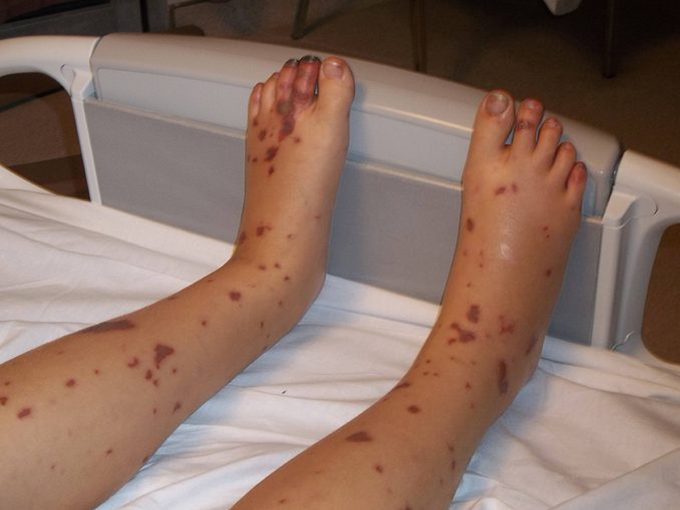A Survivor Shares Her Personal Battle with a Potentially Deadly Disease and the Importance of Being Informed
Meningitis B can be fatal, but it's also preventable. Here's everything you need to know

Babies, young children and teens are the age groups most at risk of meningitis B, a disease that can be fatal in less than 48 hours. Kate Healy shares her harrowing experience and why parents should talk to their doctor about vaccination.
Invasive meningococcal disease (IMD) is a serious bacterial infection that can cause meningitis, which is inflammation of meninges, the protective lining of the brain and spinal cord. If the infection enters the bloodstream, it can lead to septicemia, a life-threatening blood poisoning.
Most IMD cases in Canada are caused by five main groups of the bacteria Neisseria meningitidis: groups A, B, C, W-135 and Y. Meningitis B is a form of IMD that’s caused by group B strains, which cause the majority of IMD cases in Canada. Since 2007, there have been an average of 111 cases of meningitis B per year in the country.
“The incidence of meningitis B is low, but mortality is quite high,” says Dr. Christine Palmay, a family physician at the Midtown Health and Wellness Clinic in Toronto. “When it happens, it’s a huge tragedy because it’s avoidable.”

The bacteria that cause meningitis B live in the nose and throat and can be spread easily through everyday behaviours like coughing, sneezing, living in close quarters, kissing and sharing food and drinks.“ Meningitis B is a disease of proximity,” she explains. “We believe it’s transmitted through close contact, saliva, even just sharing things like utensils.” Meningococcal meningitis can cause local epidemics in university or college dorms, boarding schools and military bases.
Meningitis can impact all ages, but infants and children under five are most at risk of developing the disease, followed by adolescents aged 15-19.
Kate Healy was only 16 when she woke up one morning with cramped muscles, a fever and purplish spots on her knees. She’d just finished working as a counsellor at a summer camp. “I was feeling fluish. It’s normal if you’ve ever been to or worked at camp. Usually you get sick at some point.” By late afternoon, she’d grown extremely weak and the rash on her legs was spreading. Her parents rushed her to the hospital but her condition deteriorated rapidly. She was later airlifted to a bigger hospital and put into a coma.

Within 24 hours, Kate went from being kind of sick to critical. “They said I may not survive through the night,” she says. “My mom describes it as one of the scariest moments of her life. What do you do when you have a child who was fine and then all of a sudden isn’t?”
Doctors feared Kate would become paralyzed or suffer brain damage, but miraculously, she improved. After a week in a coma and a month in hospital, she went home. “It was really the beginning of the story, because I still had a lot of work to do,” she says. “I had physio, wound-care clinic and specialist appointments. It just began a months-long recovery.”
Because of septicemia, she lost part of a toe and had wounds on her legs that had to be cleaned, scraped and bandaged every day for two months. The scarring on her legs required corrective surgery.
Kate also lost time she can never get back. “I missed months of school. I wasn’t with friends. I was in eleventh grade, a big formative year for me. I felt isolated and lonely.” Her entire family was impacted physically, emotionally and financially. “My parents had to take time off work. My younger sister had a lot of fear and anxiety. It was a life-defining experience for all of us in different ways.”
She was incredibly fortunate not to have any serious lasting effects and knows that’s not the case for many who have contracted the disease. Up to 1 in 10 IMD patients die, often within 24–48 hours of symptom onset.
“Death is so tragic,” says Dr. Palmay. “But we often forget about morbidity, whether that’s psychological changes, losing limbs because gangrene sets in, paralysis. What about the consequences in patients who are suffering long-haul?” As many as 20% of IMD survivors experience lifelong complications such as hearing loss, mental disabilities and limb amputation.
It’s important for parents to recognize the signs and get medical attention immediately.
Early symptoms of meningitis can be hard to notice because they begin mildly and can be similar to those of a cold or flu. “The morbidity and mortality related to meningitis B cases is high,” Dr. Palmay says, “partially because symptoms are non-specific initially — general flu-like symptoms, cough, mild fever, just not feeling well.” Other early symptoms include headache, fatigue, irritability, loss of appetite, nausea, vomiting and muscle aches.

“This isn’t a disease that’s easily identifiable and it’s got huge ramifications,” she says. “By the time you’ve identified that this isn’t a general virus, you’re already at the 12-hour mark.” That’s when worrisome symptoms like neck stiffness and rashes appear. “It evolves so quickly and patients deteriorate fast. At 24 hours, in some cases where patients have been missed, they end up dying, in part because you miss so much time thinking it’s a non-serious issue.”
Your best shot at prevention is to have your child vaccinated.
Dr. Palmay recommends vaccination against meningitis B based on risk — infants are vulnerable because of their weakened immune systems, while older teenagers aged 16+ are susceptible due to contact. She suggests that parents have a discussion with their doctors about meningitis vaccines because they can be confusing.
There’s no single vaccine that protects against all vaccine-preventable strains of meningococcal bacteria.“ People assume it’s one shot, but there are multiple serotypes or groups. I spend time differentiating them with my patients and explaining why meningitis B is different.”
Most infants in Canada receive a meningococcal vaccine that covers group C strains. Teens typically receive a vaccine that protects against 4 meningococcal groups: A, C, Y and W-135. None of these vaccines protect against group B strains. Meningitis B vaccines have only been available in Canada since 2014 and aren’t currently included as part of the routine childhood vaccination schedule in most provinces. So even if your child received a meningitis vaccine, they may be missing coverage for meningitis B.
“It takes time for vaccines to be adopted,” says Dr. Palmay. “My hope would be that Canada would follow suit with countries like the UK, Portugal and Italy, which have infant immunization programs for meningitis B.”

She encourages parents to keep track of their family’s vaccinations by creating a digital record using the CANImmunize app. There are timing issues for multi-dose series vaccines like meningitis B and COVID-19, and it’s important to know what you received and when.
Unfortunately, there were no vaccines available in Canada for meningitis B when Kate contracted it. Thankfully that has now changed. Her advice is to talk to your doctor about what meningitis vaccines are available even if you think your kids are fully vaccinated. “The more proactive measures people take such as getting vaccinated, the less likely it is for anyone to experience what I went through.”
Speak to your doctor to help ensure your child is protected against all strains of vaccine-preventable meningococcal disease, including meningitis B.
Learn more at missingb.ca.





